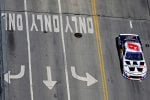Whenever NASCAR makes any type of questionable judgment call, it is often used as fodder for those who insist that such nonsense would never have happened in the golden age of NASCAR (whenever they feel that was).
I saw it again in the black hole that is social media after NASCAR botched not one but two caution flag calls during the NASCAR Cup Series race on the Chicago Street Course. There are some who cite such an occurrence as validation of the notion that NASCAR has only recently bungled such judgment calls.
There’s just one minor issue with such a claim: it’s unequivocally false.
That said, whether NASCAR made a mistake or not is an argument for another time. I’d prefer to illuminate the concept that this is absolutely not a recent phenomenon. Whatever your golden era is, I can assure you that there were plenty of bone-headed decisions that can be seen even while wearing rose-colored glasses.
The 1979 Daytona 500 is at, or at least near, the top of almost every list of the greatest races in history. But while clips of “the fight” remain a part of one video montage after another, it bears mentioning that all of the participants were at risk of more than just a black eye.
While Cale Yarborough, Donnie Allison and later Bobby Allison clashed in the grass, cars were still whisking around the track at high speed, with only the white flag having been displayed. The caution was waved alongside the checkered by the time race-leader Richard Petty came across the line but, with the race over, the cars would be slowing anyways.
At the time, there wasn’t any noticeable uproar regarding that sequence of events. Another lesser-known circumstance was that NASCAR considered penalizing Yarborough for rough driving but ultimately decided against it. This would have likely generated a more significant reaction, but NASCAR didn’t want a penalty to detract from the moment.
Perhaps you are one who feels that the 1990s were the time when everything was at its best. 1999 Cup champion Dale Jarrett and his crew chief Todd Parrott would like a word, because they have expressed feelings of being robbed after the 1998 Pontiac Excitement 400 at Richmond Raceway.
Jarrett was leading when a multicar crash took place with only six laps remaining. After throwing the caution, NASCAR then put out the red flag, claiming that it was to give the fans a chance to see a green-flag finish.
The problem with this was that it went against every precedent. Even that very year, there had already been two Cup races that finished under yellow, including the Daytona 500. One can only imagine the uproar had that particular race been red flagged in an effort to manufacture a green-flag finish.
But all of a sudden, in the middle of the year, here was NASCAR with this new idea. When racing resumed, Jarrett lost the lead on the restart to Terry Labonte.
Another crash took place just before the white flag, and the yellow flag was displayed again. Some of the drivers didn’t even realize the yellow was out, including Rusty Wallace, who raced Labonte at full speed for the entire final lap. Jarrett, who crossed the line in third but actually finished second, was not amused.
Let’s not forget about the 2000s either. Mark Martin might have a Daytona 500 trophy if this last scenario had gone a little differently.
By 2007, it was common practice for NASCAR to display the caution at the first sign of trouble. This would freeze the field, keeping drivers in their positions and allowing NASCAR to prepare for a restart or, if it was the final lap, end the race.
When Martin and Kevin Harvick led the pack off turn 4 on the last lap of the 49th annual Great American Race, contact behind them triggered a massive crash. At the moment that the crash began, Martin was ahead.
But NASCAR inexplicably withheld the caution and let the cars race back to the line. Harvick inched ahead right at the end and claimed what would be his lone Daytona 500 win. Martin finished his career without ever winning a Cup points race at Daytona.
These are just a few examples, but I can assure you that there are plenty more peppered throughout the history of NASCAR. It’s true that there are some head-scratchers recently, but such puzzling calls from race control are clearly not a recent phenomenon.
I suppose the moral of the story is that even the best of times can be marred by the most questionable decisions.
Frank Velat has been an avid follower of NASCAR and other motorsports for over 20 years. He brings a blend of passionate fan and objective author to his work. Frank offers unique perspectives that everyone can relate to, remembering the sport's past all the while embracing its future.
Follow along with @FrankVelat on Twitter.




